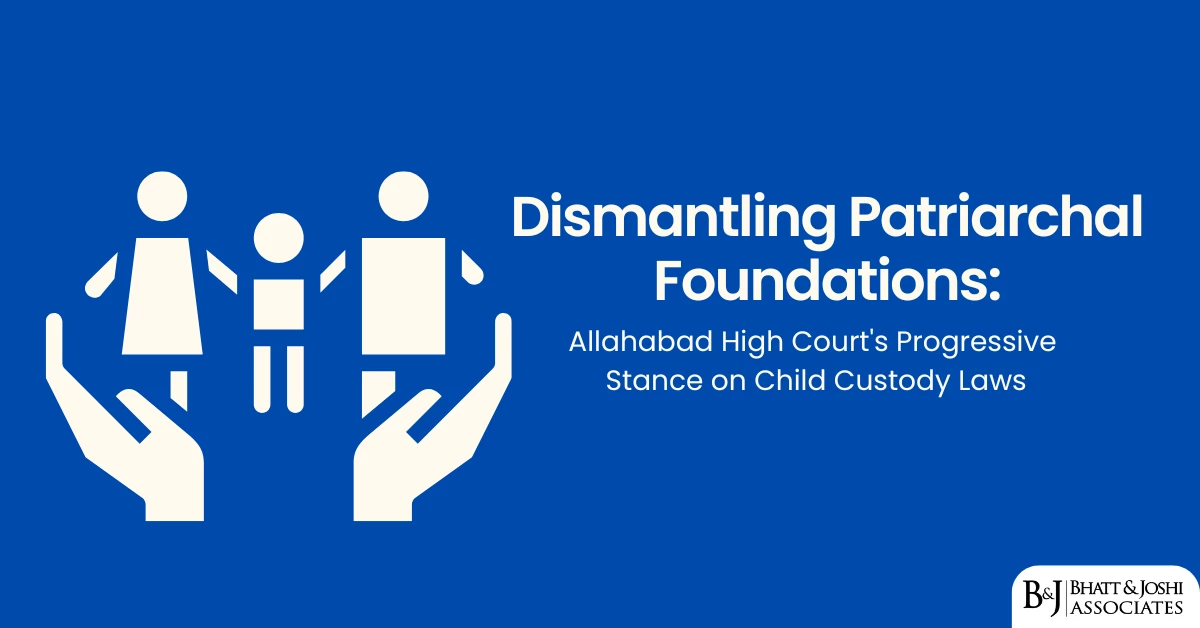Introduction
The Allahabad High Court has delivered a landmark judgment that fundamentally challenges the patriarchal underpinnings of India’s child custody laws, declaring that “father as natural guardian is no longer tenable” in contemporary legal discourse. In Saumya Sajiv Kumar Sharma and Another v. State of U.P. and Another, Justice Vinod Diwakar awarded custody of a 12-year-old girl to her mother while delivering a scathing critique of colonial-era legislation that continues to perpetuate gender-based discrimination in guardianship matters [1].
This judgment represents a significant judicial intervention in the ongoing evolution of family law, specifically addressing the inherent bias embedded in the Guardians and Wards Act, 1890, and Section 6 of the Hindu Minority and Guardianship Act, 1956. The court’s observations highlight the urgent need for legislative reform to align custody laws with constitutional principles of gender equality and the paramount consideration of child welfare.
The decision comes at a crucial juncture when Indian courts are increasingly recognizing that traditional legal frameworks, designed during colonial times, no longer adequately serve the interests of children or reflect contemporary understanding of gender equality and family dynamics in the 21st century.
Historical Context of Indian Child Custody Laws
Colonial Legacy and Patriarchal Foundations of Child Custody
The current framework governing child custody in India is largely rooted in colonial-era legislation that reflected the patriarchal social structures of the 19th century. The Guardians and Wards Act, 1890, was enacted during British rule when legal systems were designed to reinforce existing social hierarchies rather than challenge them [2].
This legislation established the principle that fathers were automatically considered the primary natural guardians of children, with mothers relegated to secondary status. The Act reflected Victorian-era assumptions about family structures, where the male head of household was presumed to be the primary decision-maker and provider, while women’s roles were confined to domestic spheres.
The Hindu Minority and Guardianship Act, 1956, while part of the post-independence Hindu Code Bills, unfortunately perpetuated these patriarchal assumptions. Section 6 of this Act explicitly states that for legitimate children, the father is the natural guardian, followed by the mother [3]. This hierarchy was established despite the constitutional commitment to gender equality enshrined in Articles 14 and 15 of the Indian Constitution.
Evolution of Judicial Interpretation
Over the decades, Indian courts have gradually recognized the limitations of these statutory frameworks. The Supreme Court’s decision in Githa Hariharan v. Reserve Bank of India (1999) marked a significant milestone by ruling that mothers could be considered natural guardians even during the father’s lifetime in certain circumstances [4].
However, despite these progressive judicial interpretations, the fundamental statutory structure remained unchanged, creating a disconnect between legal text and judicial practice. This gap has been particularly problematic in cases where traditional legal presumptions conflict with the best interests of the child.
Detailed Case Analysis: Saumya Sajiv Kumar Sharma
Factual Background and Family Dynamics
The case involved a bitter custody dispute between parents whose marriage had deteriorated, leading to separation and competing claims for their 12-year-old daughter’s custody. The father, described as a senior railway officer, had allegedly manipulated circumstances to gain and retain custody of the child through what the court characterized as conniving and scheming.
The mother had filed a complaint under the Protection of Women from Domestic Violence Act, 2005, alleging harassment by her husband, and simultaneously sought interim custody of their daughter. The initial legal proceedings reflected the traditional bias in favor of paternal custody, with both the trial court and appellate court denying the mother’s custody petition.
The courts’ decisions were influenced by the child’s expressed preference to stay with her father, a factor that the High Court later found problematic, noting that placing such burden of choice on a minor was inappropriate and potentially manipulated.
Mother’s Professional and Personal Circumstances
The mother, working as an Assistant Professor in a hospital administration department, presented a compelling case for custody based on her daughter’s developmental needs. Her argument centered on the crucial period of adolescence that her daughter was approaching, emphasizing the unique physical, emotional, and psychological support that a mother could provide during this formative phase.
The mother’s professional stability and emotional capacity to provide appropriate guidance during puberty became central to the High Court’s analysis. The court recognized that biological experience and emotional attunement are critical factors during such developmental transitions.
Father’s Household Situation
The High Court’s examination of the father’s household revealed significant limitations in providing appropriate care for a girl approaching puberty. The court noted that the child’s paternal household lacked a capable female presence, with the grandmother being a stage-3 cancer survivor and grandfather suffering from multiple health conditions.
The fact that daily household chores were handled by male servants raised concerns about the appropriateness of the environment for a young girl’s development. The court emphasized that such arrangements could not substitute for natural maternal guidance and support.
High Court’s Critical Analysis
Justice Vinod Diwakar’s judgment went beyond the immediate custody dispute to address systemic issues in Indian family law. The court’s analysis was particularly critical of the traditional approach that prioritized legal presumptions over child welfare considerations.
The court rejected the father’s claim that the child voluntarily wished to stay with him, observing that the trial court had improperly burdened the child with choosing between her parents. This observation highlighted a crucial flaw in judicial practice where children’s expressed preferences are taken at face value without considering potential manipulation or the inappropriate nature of forcing such choices on minors.
Critique of Existing Legal Framework of Child Custody and Guardianship Laws
The Guardians and Wards Act, 1890: Colonial Anachronism
The High Court’s characterization of the Guardians and Wards Act, 1890, as a colonial-era law reflecting “deeply patriarchal assumptions” represents a fundamental challenge to the continued relevance of this legislation. The court noted that the Act was “drafted at a time when patriarchal norms heavily influenced social and legal thinking” but emphasized that “over time judicial interpretations and social changes have significantly progressed” [5].
This critique extends beyond mere historical observation to question the continued validity of legal frameworks that fail to reflect contemporary understanding of gender equality and child welfare. The court’s analysis suggests that legislation designed for 19th-century social structures is inadequate for addressing 21st-century family dynamics.
Section 6 of Hindu Minority and Guardianship Act: Discriminatory Hierarchy
The court’s criticism of Section 6 of the Hindu Minority and Guardianship Act, 1956, as “outdated and discriminatory” represents a significant judicial challenge to statutory gender hierarchy. This provision’s automatic preference for fathers as natural guardians has been increasingly questioned by courts and legal scholars as inconsistent with constitutional principles of equality.
The court noted that while this provision may have reflected social realities at the time of its enactment, contemporary understanding of child development and gender roles requires a more nuanced approach that prioritizes child welfare over parental gender.
Legislative Void and Judicial Intervention
The High Court acknowledged that “judicial interpretation has commendably filled the legislative void” but emphasized that “true progress demands that the legislature codify these evolving norms to ensure a consistent and gender-neutral approach across the country.”
This observation highlights the tension between progressive judicial interpretation and outdated statutory frameworks. The court’s call for legislative reform recognizes that while judicial decisions can provide temporary relief, comprehensive reform requires legislative action to ensure consistency and predictability in legal outcomes.
The Primacy of Child Welfare Principle
Constitutional Basis of Child Welfare in Custody
The principle that child welfare is paramount in custody decisions is firmly grounded in constitutional jurisprudence. Article 15(3) of the Constitution specifically permits the state to make special provisions for children, while Article 39(e) and (f) direct the state to ensure that children are protected against exploitation and given opportunities for healthy development.
The Supreme Court has consistently held that in custody matters, “welfare of the child” is of paramount consideration, superseding the rights and claims of parents [6]. This principle has been reinforced in numerous judgments, establishing that custody decisions must be based on what serves the child’s best interests rather than parental rights or social conventions.
Best Interests Standard in Practice
The application of the best interests standard requires courts to consider multiple factors including the child’s physical and emotional needs, the stability of the proposed environment, the capacity of each parent to provide care, and the child’s own developmental requirements.
In the present case, the High Court’s analysis demonstrated how this standard should be applied, considering factors such as:
- Developmental Needs: The court recognized that a girl approaching puberty has specific needs that may be better addressed by a mother’s guidance and support.
- Environmental Stability: The assessment of both households to determine which could provide more appropriate care and supervision.
- Emotional Support: Recognition that emotional attunement and understanding are crucial during formative years.
- Practical Considerations: Evaluation of the practical arrangements for the child’s daily care and supervision.
Gender-Sensitive Application
The High Court’s decision reflects a gender-sensitive application of the best interests standard, recognizing that different stages of a child’s development may require different types of support and guidance. The court’s observation that “preferential custodial rights of the mother must be recognised, especially in the case of a female child approaching puberty” represents a significant departure from gender-neutral approaches that ignore the realities of child development.
Progressive Judicial Interpretation and Legal Evolution
From Paternal Preference to Child-Centric Approach
Indian courts have gradually evolved from a presumptive preference for paternal custody to a more nuanced, child-centric approach. This evolution reflects broader changes in social understanding of family dynamics, gender roles, and child development.
Early post-independence judgments often reflected traditional social assumptions about gender roles and family structures. However, contemporary judicial decisions increasingly recognize that effective parenting is not determined by gender but by capacity, commitment, and circumstances.
Recognition of Maternal Rights and Capabilities
The High Court’s decision represents part of a broader judicial trend recognizing maternal rights and capabilities in custody matters. Courts have increasingly acknowledged that mothers’ traditional roles in child-rearing may provide them with particular insights and capabilities relevant to child welfare.
This recognition extends beyond mere acknowledgment of maternal bonds to encompass practical considerations such as understanding of child development, emotional support capabilities, and the ability to provide guidance during crucial developmental phases.
Challenging Systemic Bias
The judgment’s explicit recognition of “patriarchal bias” in custody laws represents a significant judicial acknowledgment of systemic discrimination. This recognition is crucial for addressing not just individual cases but the broader structural issues that perpetuate gender-based discrimination in family law.
The court’s critique extends to judicial attitudes and practices, noting that outdated mindsets can perpetuate discrimination even when legal frameworks allow for more progressive interpretations.
Contemporary Challenges in Family Law
Balancing Tradition and Progress
One of the significant challenges in reforming family law lies in balancing respect for cultural traditions with the need for progressive legal frameworks that reflect contemporary understanding of gender equality and child welfare.
The tension between traditional family structures and modern legal principles requires careful navigation to ensure that legal reforms are both effective and socially acceptable. Courts must consider how legal changes will be implemented and accepted within existing social frameworks.
Ensuring Consistent Application
The High Court’s call for legislative codification reflects concerns about inconsistent application of progressive principles across different courts and jurisdictions. While some courts have adopted child-centric, gender-sensitive approaches, others may continue to apply traditional presumptions.
Ensuring consistent application of progressive principles requires comprehensive legal reform that provides clear guidance to courts while maintaining sufficient flexibility to address individual circumstances.
Addressing Systemic Discrimination
The challenge of addressing systemic discrimination in family law extends beyond changing legal texts to transforming attitudes and practices within the legal system. This requires ongoing education and training for judicial officers, lawyers, and other legal professionals.
International Perspectives and Best Practices
Global Trends in Custody Law Reform
International trends in custody law reform have increasingly moved toward gender-neutral frameworks that prioritize child welfare over parental rights or traditional assumptions about gender roles. Many jurisdictions have adopted principles of shared parenting and joint custody as default positions, subject to considerations of child welfare.
The United Nations Convention on the Rights of the Child has been influential in establishing international standards that prioritize child welfare and best interests in custody decisions. These standards have been incorporated into domestic legislation in many countries, providing models for potential reform in India.
Comparative Legal Analysis
Comparative analysis of custody law reforms in other jurisdictions provides valuable insights for potential reforms in India. Countries such as Australia, the United Kingdom, and several European nations have successfully reformed their custody laws to eliminate gender-based presumptions while maintaining focus on child welfare.
These reforms have typically involved comprehensive legislative overhaul combined with judicial training and public education to ensure effective implementation. The experiences of these jurisdictions suggest that successful reform requires coordinated efforts across multiple levels of the legal system.
Implications for Legal Practice and Reform in Child Custody Cases
Immediate Practical Implications
The High Court’s decision provides immediate guidance for legal practitioners handling custody cases, emphasizing the need to:
- Focus on Child Welfare: Practitioners must prioritize child welfare considerations over traditional legal presumptions or parental rights arguments.
- Present Gender-Sensitive Arguments: Legal arguments should recognize that different developmental stages may require different types of support and guidance.
- Challenge Systemic Bias: Practitioners should be prepared to challenge traditional assumptions and biases that may influence judicial decision-making.
- Document Parental Capacity: Emphasis should be placed on demonstrating actual parental capacity and circumstances rather than relying on legal presumptions.
Legislative Reform Priorities
The judgment identifies several priorities for legislative reform:
- Gender-Neutral Language: Statutory provisions should be amended to remove gender-based hierarchies in guardianship rights.
- Child-Centric Framework: Legislation should be restructured to prioritize child welfare as the primary consideration in all custody decisions.
- Flexible Application: Legal frameworks should provide sufficient flexibility to address diverse family circumstances and child development needs.
- Procedural Safeguards: Enhanced procedural safeguards should be implemented to prevent manipulation and ensure that children’s voices are heard appropriately.
Judicial Training and Education
The decision highlights the need for enhanced judicial training and education to address systemic bias and ensure consistent application of progressive principles. This includes:
- Gender Sensitivity Training: Judicial officers should receive training on gender sensitivity and the impact of traditional biases on legal decision-making.
- Child Development Education: Understanding of child development principles should be incorporated into judicial training programs.
- Best Practices Dissemination: Successful approaches and decisions should be systematically shared to promote consistent application of progressive principles.
Long-term Implications for Indian Family Law
Evolutionary Trajectory
The High Court’s decision represents part of a broader evolutionary trajectory in Indian family law, moving from traditional, patriarchal frameworks toward more egalitarian, child-centric approaches. This evolution reflects broader social changes and increasing recognition of gender equality principles.
The trajectory suggests that future developments in family law will continue to prioritize child welfare while eliminating gender-based discrimination. This evolution is likely to be gradual but persistent, driven by both judicial interpretation and social change.
Potential for Comprehensive Reform
The judgment’s explicit call for legislative reform suggests potential for comprehensive overhaul of India’s family law framework. Such reform would need to address not only custody and guardianship provisions but also related areas such as maintenance, inheritance, and family property rights.
Comprehensive reform would require careful coordination between different statutory frameworks to ensure consistency and eliminate conflicting provisions that perpetuate discrimination or confusion.
Social Impact and Acceptance
The long-term success of legal reforms depends significantly on social acceptance and cultural adaptation. The High Court’s decision reflects changing social attitudes toward gender roles and family structures, but implementation will require ongoing social dialogue and education.
The impact of legal reforms on social attitudes and practices is likely to be gradual but significant, contributing to broader changes in how society understands and organizes family relationships.
Conclusion
The Allahabad High Court’s decision in Saumya Sajiv Kumar Sharma and Another v. State of U.P. and Another represents a watershed moment in the evolution of Indian family law. By explicitly challenging the patriarchal foundations of existing custody legislation and declaring that “father as natural guardian is no longer tenable,” the court has provided a powerful judicial statement on the need for fundamental reform in how Indian law approaches child custody and guardianship.
The judgment’s significance extends far beyond the immediate case to address systemic issues that have long plagued Indian family law. The court’s critique of colonial-era legislation and its call for gender-neutral, child-centric legal frameworks reflects a mature understanding of the tensions between traditional legal structures and contemporary social realities.
The decision demonstrates how progressive judicial interpretation can serve as a catalyst for broader legal and social reform. By explicitly recognizing and condemning patriarchal bias in existing laws, the court has created space for more equitable approaches to child custody that prioritize child welfare over traditional gender hierarchies.
The court’s emphasis on the developmental needs of children, particularly girls approaching puberty, reflects a sophisticated understanding of child development that recognizes the importance of appropriate support and guidance during crucial developmental phases. This approach represents a significant advancement over traditional frameworks that treated all children identically regardless of their specific developmental needs.
The judgment’s call for legislative reform is particularly significant, recognizing that while judicial interpretation can provide temporary relief and progressive guidance, comprehensive reform requires legislative action to ensure consistency and predictability in legal outcomes. The court’s observation that “true progress demands that the legislature codify these evolving norms” provides a roadmap for future reform efforts.
The decision also highlights the ongoing tension between progressive judicial interpretation and outdated statutory frameworks. This tension underscores the need for coordinated reform efforts that address both legal texts and judicial practices to ensure effective implementation of progressive principles.
Looking forward, the judgment provides a foundation for continued evolution in Indian family law. The principles established in this decision are likely to influence future judicial decisions and may serve as a catalyst for broader legislative reform efforts. The explicit recognition of systemic bias and the call for gender-neutral legal frameworks provide clear direction for future reform initiatives.
The long-term impact of this decision will likely extend beyond custody law to influence broader areas of family law and gender equality jurisprudence. The court’s approach demonstrates how legal systems can evolve to reflect changing social understanding while maintaining focus on fundamental principles of child welfare and gender equality.
Ultimately, this judgment represents not just a legal decision but a social statement about the kind of society India aspires to become. By challenging patriarchal assumptions and prioritizing child welfare over traditional gender hierarchies, the court has contributed to ongoing efforts to create a more equitable and just legal system that serves the needs of all family members while protecting the most vulnerable.
The decision serves as both a critique of existing legal frameworks and a vision for future reform, providing guidance for legal practitioners, lawmakers, and social advocates working toward more equitable and effective family law systems. As Indian society continues to evolve and modernize, decisions like this will play a crucial role in ensuring that legal frameworks keep pace with social change while maintaining focus on fundamental principles of justice and equality.
References
[1] Saumya Sajiv Kumar Sharma and Another v. State of U.P. and Another, Allahabad High Court, Justice Vinod Diwakar, June 23, 2025. https://lawbeat.in/news-updates/father-as-natural-guardian-no-longer-tenable-allahabad-hc-flags-patriarchal-bias-in-custody-laws-1489941
[2] Brief Introduction to Guardian and Wards Act, 1890. https://restthecase.com/knowledge-bank/guardian-and-wards-act-of-1890
[3] Hindu Minority and Guardianship Act, 1956 – Section 6 Natural Guardians. https://blog.ipleaders.in/overview-of-the-hindu-minority-and-guardianship-act-1956/
[4] Githa Hariharan v. Reserve Bank of India – Child Custody and Natural Guardianship. https://blog.ipleaders.in/child-custody-respect-indian-laws/
[5] Minority and Guardianship under the Guardian and Wards Act, 1890. https://blog.ipleaders.in/minority-guardianship-guardian-wards-act-1890/
[6] Child Custody Laws India – Best Interest of Child Principle. https://www.scconline.com/blog/post/2019/11/25/custody-of-children/
[7] Hindu Minority and Guardianship Act, 1956 – Wikipedia. https://en.wikipedia.org/wiki/Hindu_Minority_and_Guardianship_Act,_1956
[8] Supreme Court Digital Reports – Child Custody Welfare Principle. https://digiscr.sci.gov.in/html_view?dir=YWRtaW4vanVkZ2VtZW50X2ZpbGUvZWJvb2tzLzIwMjQvdm9sdW1lIDMvUGFydCBJLzIwMjQzMTAyMjE3MTAzOTUzMzAuaHRtbA%3D%3D&judgment_id=MzcxOTg%3D
[9] A Guide to Custody of Girl Child in India. https://amlegal.in/custody-of-girl-child-in-india/
[10] Law on Child Custody in India – Legal Framework. https://xpertslegal.com/blog/law-on-child-custody-in-india/
[11] Child Custody Laws in India – Comprehensive Guide. https://lawrato.com/indian-kanoon/child-custody-law/child-custody-laws-in-india-2691
[12] All One Needs to Know About Child Custody. https://blog.ipleaders.in/all-one-needs-to-know-about-child-custody/
[13] Child Custody Laws in India – Legal Framework Overview. https://www.indialawoffices.com/knowledge-centre/child-custody-laws-in-india
[14] An Overview of Child Custody Laws in India. https://lawansweronline.com/blog/child-custody-laws-in-india/
[15] Maintenance Under the Guardians & Wards Act, 1890. https://www.scconline.com/blog/post/2025/01/15/maintenance-under-the-guardians-wards-act-1890-an-interpretative-analysis/












